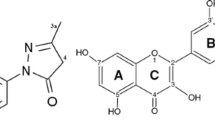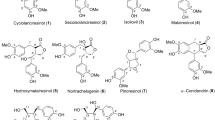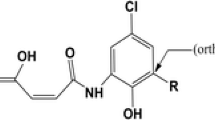Abstract
The calculations of local reactivity descriptors, the electron donor Fukui function f ˉ(r), the average local ionization energy Ī(r), the Fukui function dual descriptor f (2)(r), and the electron acceptor Fukui function f +(r) for α-tocopherol, the main biologically active form of vitamin E for antioxidant reactions in phospholipid membranes, is presented. The calculations are performed at B3LYP/6-311++G** level of theory in the gas-phase. The obtained results indicate that the most preferred sites for donating electron in a reaction with radical or oxidizing molecule are associated mostly with π electrons above and below the aromatic part of the α-tocopherol chromanol ring. The most reactive sites for accepting electrons are associated with the leaving H(9) atom in the extension of the phenolic OH bond on the α-tocopherol chromanol ring plane, in the place where the formation of H-bond of the precursor complex between approaching reactive oxygen radical and phenolic OH group of α-tocopherol could be expected. The separated reactive sites in α-tocopherol suggest that the proton and electron, along with the hydrogen atom transfer (HAT) process, could also be transferred to different proton and electron acceptors as in bidirectional proton coupled electron transfer (PCET) reactions. The results presented in this paper suggest that large charge redistribution and significant π-π interactions may be expected in antioxidant reactions of α-tocopherol.

The DFT local reactivity descriptors reveal electron donor (blue) and acceptor (red) reactive sites and can be used in research of the initial stage of α-tocopherol antioxidant reactions






Similar content being viewed by others
References
Burton GW, Ingold KU (1986) Vitamin E: application of the principles of physical organic chemistry to the exploration of its structure and function. Acc Chem Res 19:194–201. doi:10.1021/ar00127a001
Mustacich DJ, Bruno RS, Traber MG (2007) Vitamin E. In: Litwack G (ed) Vitamin E: vitamins and hormones. Elsevier, San Diego, pp 1–21. doi:10.1016/S0083-6729(07)76001-6
Niki E (2014) Role of vitamin E as a lipid-soluble peroxyl radical scavenger: in vitro and in vivo evidence. Free Radic Biol Med 66:3–12. doi:10.1016/j.freeradbiomed.2013.03.022
Traber MG, Stevens JF (2011) Vitamins C and E: beneficial effects from a mechanistic perspective. Free Radic Biol Med 51:1000–1013. doi:10.1016/j.freeradbiomed.2011.05.017
Azzi A (2007) Molecular mechanism of α-tocopherol action. Free Radic Biol Med 43:16–21. doi:10.1016/j.freeradbiomed.2007.03.013
Jiang Q (2014) Natural forms of vitamin E: metabolism, antioxidant, and anti-inflammatory activities and their role in disease prevention and therapy. Free Radic Biol Med 72:76–90. doi:10.1016/j.freeradbiomed.2014.03.035
Boscoboinik D, Szewczyk A, Hensey C, Azzi A (1991) Inhibition of cell-proliferation by alpha-tocopherol - role of protein-kinase-C. J Biol Chem 266:6188–6194
Chojkier M, Houglum K, Lee KS, Buck M (1998) Long- and short-term D-alpha-tocopherol supplementation inhibits liver collagen alpha1(I) gene expression. Am J Physiol 275:G1480–1485
Aratri E, Spycher SE, Breyer I, Azzi A (1999) Modulation of alpha-tropomyosin expression by alpha-tocopherol in rat vascular smooth muscle cells. FEBS Lett 447:91–94. doi:10.1016/S0014-5793(99)00277-X
Burton GW, Doba T, Gabe E, Hughes L, Lee FL, Prasad L, Ingold KU (1985) Autoxidation of biological molecules. 4. Maximizing the antioxidant activity of phenols. J Am Chem Soc 107:7053–7065. doi:10.1021/ja00310a049
Burton GW, Ingold KU (1981) Autoxidation of biological molecules. 1. Antioxidant activity of vitamin E and related chain-breaking phenolic antioxidants in vitro. J Am Chem Soc 103:6472–6477. doi:10.1021/ja00411a035
Marquardt D, Williams JA, Kučerka N, Atkinson J, Wassall SR, Katsaras J, Harroun TA (2013) Tocopherol activity correlates with its location in a membrane: a new perspective on the antioxidant vitamin E. J Am Chem Soc 135:7523–7533. doi:10.1021/ja312665r
Yoshida Y, Niki E, Noguchi N (2003) Comparative study on the action of tocopherols and tocotrienols as antioxidant: chemical and physical effects. Chem Phys Lipids 123:63–75. doi:10.1016/S0009-3084(02)00164-0
Nagaoka S, Inoue M, Nishioka C, Nishioku Y, Tsunoda S, Ohguchi C, Ohara K, Mukai K, Nagashima U (2000) Tunneling effect in antioxidant, prooxidant, and regeneration reactions of vitamin E. J Phys Chem B 104:856–862. doi:10.1021/jp9932113
Nagaoka S, Kuranaka A, Tsuboi H, Nagashima U, Mukai K (1992) Mechanism of antioxidant reaction of vitamin E: charge transfer and tunneling effect in proton-transfer reaction. J Phys Chem 96:2754–2761. doi:10.1021/j100185a065
Wright JS, Carpenter DJ, McKay DJ, Ingold KU (1997) Theoretical calculation of substituent effects on the O−H bond strength of phenolic antioxidants related to vitamin E. J Am Chem Soc 119:4245–4252. doi:10.1021/ja963378z
Rosenau T, Ebner G, Stanger A, Perl S, Nuri L (2005) From a theoretical concept to biochemical reactions: strain-induced bond localization (SIBL) in oxidation of vitamin E. Chem Eur J 11:280–287. doi:10.1002/chem.200400265
Inagaki T, Yamamoto T (2014) Critical role of deep hydrogen tunneling to accelerate the antioxidant reaction of ubiquinol and vitamin E. J Phys Chem B 118:937–950. doi:10.1021/jp410263f
Navarrete M, Rangel C, Corchado JC, Espinosa-Garcia J (2005) Trapping of the OH radical by α-tocopherol: a theoretical study. J Phys Chem A 109:4777–4784. doi:10.1021/jp050717e
Navarrete M, Rangel C, Espinosa-García J, Corchado JC (2005) Theoretical study of the antioxidant activity of vitamin E: reactions of α-tocopherol with the hydroperoxy radical. J Chem Theory Comput 1:337–344. doi:10.1021/ct0498932
Gutiérrez-Oliva S (2011) Theoretical study of the hydrogen abstraction from vitamin-E analogues. The usefulness of DFT descriptors. J Mol Model 17:593–598. doi:10.1007/s00894-010-0759-8
Zhang H-Y, Ji H-F (2006) How vitamin E scavenges DPPH radicals in polar protic media. New J Chem 30:503–504. doi:10.1039/B600025H
Musialik M, Litwinienko G (2005) Scavenging of dpph • radicals by vitamin E Is accelerated by Its partial ionization: the role of sequential proton loss electron transfer. Org Lett 7:4951–4954. doi:10.1021/ol051962j
Klein E, Lukeš V, Ilčin M (2007) DFT/B3LYP study of tocopherols and chromans antioxidant action energetics. Chem Phys 336:51–57. doi:10.1016/j.chemphys.2007.05.007
Martínez A, Rodríguez-Gironés MA, Barbosa A, Costas M (2008) Donator acceptor map for carotenoids, melatonin and vitamins. J Phys Chem A 112:9037–9042. doi:10.1021/jp803218e
Singh NK, O’Malley PJ, Popelier PLA (2007) Electronic structure calculations of vitamin E analogues: a model for calculated geometries, hyperfine coupling constants, reaction enthalpies (ΔHr) and relative bond dissociation enthalpies (ΔBDE). J Mol Struct (THEOCHEM) 811:249–254. doi:10.1016/j.theochem.2007.01.034
Parr RG, Yang W (1989) Density functional theory of atoms and molecules. Oxford University Press, Oxford
Parr RG, Yang W (1995) Density-functional theory of the electronic-structure of molecules. Annu Rev Phys Chem 46:701–728. doi:10.1146/annurev.pc.46.100195.003413
Chattaraj PK (2009) Chemical reactivity theory: a density functional view. CRC, Boca Raton
Geerlings P, Fias S, Boisdenghien Z, De Proft F (2014) Conceptual DFT: chemistry from the linear response function. Chem Soc Rev 43:4989–5008. doi:10.1039/c3cs60456j
Parr RG, Yang W (1984) Density functional approach to the frontier-electron theory of chemical reactivity. J Am Chem Soc 106:4049–4050. doi:10.1021/ja00326a036
Ayers PW, Yang W, Bartolotti LJ (2009) Fukui function. In: Chattaraj PK (ed) Chemical reactivity theory. A density functional view. CRC, New York, pp 255–267
Morell C, Grand A, Gutiérrez-Oliva S, Toro-Labbé A (2007) Using the reactivity-selectivity descriptor Δf(r) in organic chemistry. In: Toro-Labbé A (Ed.) Theoretical aspects of chemical reactivity. Elsevier, Dordrecht, pp 101–117
Fuentealba P, Florez E, Tiznado W (2010) Topological analysis of the fukui function. J Chem Theory Comput 6:1470–1478. doi:10.1021/ct100022w
Pilepić V, Uršić S (2001) Nucleophilic reactivity of the nitroso group. Fukui function DFT calculations for nitrosobenzene and 2-methyl-2-nitrosopropane. J Mol Struct (THEOCHEM) 538:41–49. doi:10.1016/S0166-1280(00)00642-4
Brala Jakobušić C, Fabijanić I, Marković AK, Pilepić V (2014) The average local ionization energy and Fukui function of L-ascorbate, the local reactivity descriptors of antioxidant reactivity. Comput Theor Chem 1049:1–6. doi:10.1016/j.comptc.2014.09.008
Cardenas C, Rabi N, Ayers PW et al (2009) Chemical reactivity descriptors for ambiphilic reagents: dual descriptor, local hypersoftness, and electrostatic potential. J Phys Chem A 113:8660–8667. doi:10.1021/jp902792n
Politzer P, Murray JS, Bulat FA (2010) Average local ionization energy: a review. J Mol Model 16:1731–1742. doi:10.1007/s00894-010-0709-5
Politzer P, Murray JS (2007) The Average Local Ionization Energy: Concepts and Applications. In: Toro-Labbé A (Ed.) Theoretical aspects of chemical reactivity. Elsevier, Dordrecht, pp 119–137
Murray JS, Shields ZP-I, Lane P et al (2013) The average local ionization energy as a tool for identifying reactive sites on defect-containing model graphene systems. J Mol Model 19:2825–2833. doi:10.1007/s00894-012-1693-8
Stephens PJ, Devlin FL, Chabalowski CF, Frisch MJ (1994) Ab initio calculation of vibrational absorption and circular dichroism spectra using density functional force fields. J Phys Chem 98:11623–11627. doi:10.1021/j100096a001
Hehre WJ, Radom L, Schleyer P, Pople JA (1987) Ab initio molecular orbital theory. Wiley, New York
Frisch MJ, Trucks GW, Schlegel HB, Scuseria GE, Robb MA, Cheeseman JR, Scalmani G, Barone V, Mennucci B, Petersson GA, Nakatsuji H, Caricato M, Li X, Hratchian HP, Izmaylov AF, Bloino J, Zheng G, Sonnenberg JL, Hada M, Ehara M, Toyota K, Fukuda R, Hasegawa J, Ishida M, Nakajima T, Honda Y, Kitao O, Nakai H, Vreven T, Montgomery JA Jr, Peralta JE, Ogliaro F, Bearpark M, Heyd JJ, Brothers E, Kudin KN, Staroverov VN, Kobayashi R, Normand J, Raghavachari K, Rendell A, Burant JC, Iyengar SS, Tomasi J, Cossi M, Rega N, Millam MJ, Klene M, Knox JE, Cross JB, Bakken V, Adamo C, Jaramillo J, Gomperts R, Stratmann RE, Yazyev O, Austin AJ, Cammi R, Pomelli C, Ochterski JW, Martin RL, Morokuma K, Zakrzewski VG, Voth GA, Salvador P, Dannenberg JJ, Dapprich S, Daniels AD, Farkas Ö, Foresman JB, Ortiz JV, Cioslowski J, Fox DJ (2009) Gaussian 09, revision D.01. Gaussian Inc, Wallingford
Lu T, Chen F (2012) Multiwfn: a multifunctional wavefunction analyzer. J Comput Chem 33:580–592. doi:10.1002/jcc.22885, Version 3.3.5
Dennington R, Keith T, Millam J (2006) GaussView, version 4.1.2. Semichem Inc, Shawnee
Qin SS, Yu ZW, Yu Y-X (2009) Structural and kinetic properties of α-tocopherol in phospholipid bilayers, a molecular dynamics simulation study. J Phys Chem B 113:16537–16546. doi:10.1021/jp9074306
Toro-Labbé A, Jaque P, Murray JS, Politzer P (2005) Connection between the average local ionization energy and the Fukui function. Chem Phys Lett 407:143–146. doi:10.1016/j.cplett.2005.03.041
Sirjoosingh A, Hammes-Schiffer S (2011) Proton-coupled electron transfer versus hydrogen atom transfer: generation of charge-localized diabatic states. J Phys Chem A 115:2367–2377. doi:10.1021/jp111210c
Mayer JM (2004) Proton-coupled electron transfer: A reaction chemist’s view. Annu Rev Phys Chem 55:363–390. doi:10.1146/annurev.physchem.55.091602.094446
Mayer JM, Hrovat DA, Thomas JL, Borden WT (2002) Proton-coupled electron transfer versus hydrogen atom transfer in benzyl/toluene, methoxyl/methanol, and phenoxyl/phenol self-exchange reactions. J Am Chem Soc 124:11142–11147. doi:10.1021/ja012732c
DiLabio GA, Johnson ER (2007) Lone pair-π and π-π interactions play an important role in proton-coupled electron transfer reactions. J Am Chem Soc 129:6199–6203. doi:10.1021/ja068090g
Kaila VRI, Hummer G (2011) Energetics of direct and water-mediated proton-coupled electron transfer. J Am Chem Soc 133:19040–19043. doi:10.1021/ja2082262
Tishchenko O, Truhlar DG, Ceulemans A, Nguyen MT (2008) A unified perspective on the hydrogen atom transfer and proton-coupled electron transfer mechanisms in terms of topographic features of the ground and excited potential energy surfaces as exemplified by the reaction between phenol and radicals. J Am Chem Soc 130:7000–7010. doi:10.1021/ja7102907
Zhong A, Ge C, Liang H, Jiang H, Zhou Q (2012) Proton–coupled electron transfer versus hydrogen atom transfer: a density functional reactivity theory characterization. Comput Theor Chem 988:13–18. doi:10.1016/j.comptc.2012.02.020
Acknowledgments
We thank the University of Zagreb Computing Centre (SRCE) for providing the computing facilities and Croatian Ministry of Science, Education and Sports for support (Project: 006-3082-0354). We also thank the referee for the suggestion to include frontier molecular orbitals in the consideration.
Compliance with ethical standards
ᅟ
Funding
This study was funded by Croatian Ministry of Science, Education and Sports (grant number 006-3082-0354).
Conflict of interest
The authors declare that they have no conflict of interest.
Author information
Authors and Affiliations
Corresponding author
Rights and permissions
About this article
Cite this article
Fabijanić, I., Jakobušić Brala, C. & Pilepić, V. The DFT local reactivity descriptors of α-tocopherol. J Mol Model 21, 99 (2015). https://doi.org/10.1007/s00894-015-2644-y
Received:
Accepted:
Published:
DOI: https://doi.org/10.1007/s00894-015-2644-y




